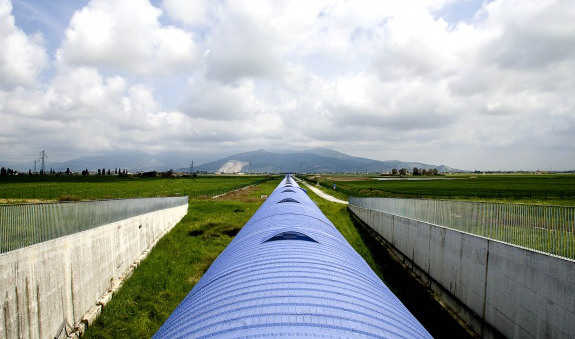
Today, Tuesday August 1st 2017, the VIRGO detector based in Italy has officially joined “Observation Run 2” (O2) and is now taking data alongside the American-based twin LIGO detectors.
VIRGO Press Release -
Today, Tuesday August 1st 2017, the VIRGO detector based in Europe has officially joined “Observation Run 2” (O2) and is now taking data alongside the American-based twin LIGO detectors. This major step forward for the VIRGO Collaboration is the outcome of a multi-year upgrade program, whose primary goal was to significantly improve the detector performance in terms of sensitivity. “The last months have been spent on commissioning VIRGO, and this went very well. We are eager to start our first science run, joining LIGO at this exciting time for our field” says Jo van den Brand of Nikhef and VU University Amsterdam, the spokesperson of the VIRGO collaboration. Although the VIRGO sensitivity is, for the time being, at a lower level of those of the LIGO interferometers, it is adequate for confirming a potential detection with LIGO and would allow locating sources of gravitational waves in the sky with greater accuracy. The current VIRGO sensitivity significantly exceeds the previous VIRGO record sensitivity, achieved in 2011 before dismantling the detector to start its upgrade. VIRGO is now a brand new instrument comprising several new components, which have been made work together in less than one year, during the so-called commissioning phase. “It took many years of intense and innovative work to realize the ambitious objectives of the VIRGO upgrade. I wish to recognize the dedication of the members of the VIRGO Collaboration, of the EGO staff and of the participating labs” says Federico Ferrini, the director of the European Gravitational Observatory (EGO). The O2 data-taking phase started on November 30, 2016 and will end on August 25, 2017. It has already led to the discovery of a third stellar-mass black hole binary coalescence, GW170104, recorded on January 4, 2017 and announced by LIGO and VIRGO last June 1st 2017. The joint data analyses are still ongoing while more data are being recorded, for the first time with three advanced instruments. David Shoemaker from MIT, the LIGO Scientific Collaboration Spokesperson, notes that “While the detections to date with the LIGO instruments have been rich with scientific reward, we are really moving into a new domain being able to observe with three detectors. The deep collaboration between VIRGO and LIGO allows us to make the most of this new configuration.” The present data taking period, which is more than an achievement, represents the beginning of a new era for the VIRGO Collaboration. After the completion of O2, the VIRGO operation will proceed to further improve the sensitivity of the detector and to gain more knowledge about the main sources of noise that are currently limiting it. Then, a new upgrade phase will start, where several key improvements will be made, among which the installation of monolithic suspensions. The mirrors will be indeed suspended by thin and strong fused-silica fibers, which will replace the current metal wires. Later, in Spring 2018, a new commissioning phase will start, with the goal of having a more sensitive detector by the time the LIGO-VIRGO “Observation Run 3” (O3) starts in Fall 2018. “The months ahead of us will be exciting and challenging. These upgrades are promising further improvements of the sensitivity, while making the instruments more complex. Our commitment will consist in fully exploiting the new technologies installed on the detector”, says Alessio Rocchi from INFN Roma Tor Vergata, the commissioning coordinator of the VIRGO collaboration. “Today, for the first time, we have a network of three second generation detectors capable of localizing the source of a gravitational-wave signal. This is a major achievement and the best is yet to come: the sensitivity of the involved detectors will progressively improve and more detectors are expected to join in the next years, opening exciting perspectives for the multi-messenger investigation of our universe”, concludes Giovanni Losurdo from INFN Pisa who has been the leader of the “Advanced VIRGO” project. The VIRGO Collaboration, consists of more than 280 physicists and engineers belonging to 20 different European research groups: six from Centre National de la Recherche Scientifique (CNRS) in France; eight from the Istituto Nazionale di Fisica Nucleare (INFN) in Italy; two in The Netherlands with Nikhef; the MTA Wigner RCP in Hungary; the POLGRAW group in Poland; Spain with the University of Valencia; and EGO, the laboratory hosting the VIRGO detector near Pisa in Italy.






